TCMSP User Guide
Bohui Li*
Lab of Systems Pharmacology, Center of Bioinformatics, College of Life Science, Northwest University, China.
* Email: 2009013706@nwsuaf.edu.cn
TCMSP is not only a data repository, but also an analysis platform for users to comprehensively study Traditional Chinese Medicines (TCM): including identification of active components, screening of drug targets and generation of compounds-targets-diseases networks, as well as the detailed drug pharmacokinetic information involving drug-likeness (DL), oral bioavailability (OB), blood-brain barrier (BBB),intestinal epithelial permeability (Caco-2), ALogP,fractional negative surface area (FASA-) and number of H-bond donor/acceptor (Hdon/Hacc). So far, TCMSP has attracted broad attentions and several groups have published more than 10 papers by using our TCMSP database within about one year (Wang et al., 2013; Lu et al., 2012).Here, we provide one example to illustrate how to use TCMSP (H. Liu et al., 2013).
Purpose:Licorice (glycyrrhizae), one of the oldest and most popular herbal medicines in the world, has been widely used in traditional Chinese medicine as a cough reliever, anti-inflammatory, anti-anabrosis, immunomodulatory, anti-platelet, antiviral (hepatitis) and detoxifying agent. However, due to its extreme complexity both in chemical components and mechanisms of action, deep understanding of licorice is still difficult. Thus, a novel systems pharmacology model based on TCMSP was proposed for the purpose of screening active ingredients, identifying drug targets and diseases, and understanding the biological basis of pharmacology of licorice. To investigate herb of interest, normally five steps as following are required.
1) Searching.First of all, we use licorice (or Chinese name 甘草/gancao ) as a bait to search in the search box and the results are shown as Figure1, or seeking for licorice in the “browse database” page in TCMSP . (Under the search box, one can also search with chemical name, InChIKey and CAS number for getting the ingredients information; with target name for protein information, and with disease name for disease details)

Figure 1. Graphical representation of searching herbs
2) Ingredient information. Subsequently, all ingredients involved in licorice that detailed in molecule names, and other 10 ADME-related parameters are listed (Figure 2). All compounds have the 3D structures and can be downloaded directly.
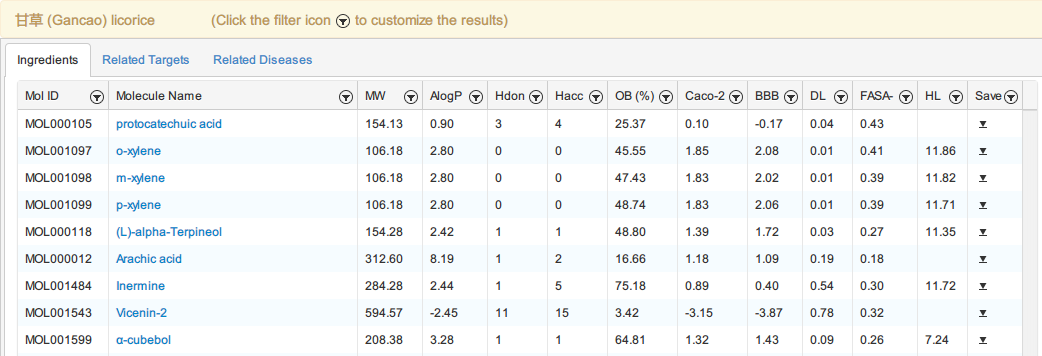
Figure 2.Licorice ingredients information and parameters
3) ADME screening.Notably, the most powerful function of TCMSP is that we can obtain the ideal active compounds under various screening criterions,with the filter rules of “equal to”,“greater than” and “less than”, and etc. by using the filtericon  at the top of each column (Figure3). The large-scale molecular information and pharmacokinetic parameters, as well asthe special function of screening active compounds, make a great convenience for users to further analyze TCM. For example, in research of licorice, we set the criterion of OB greater than 40% and DL greater than 0.18 (Figure 3), and a total of 73 potential active compounds have been obtained.
at the top of each column (Figure3). The large-scale molecular information and pharmacokinetic parameters, as well asthe special function of screening active compounds, make a great convenience for users to further analyze TCM. For example, in research of licorice, we set the criterion of OB greater than 40% and DL greater than 0.18 (Figure 3), and a total of 73 potential active compounds have been obtained.
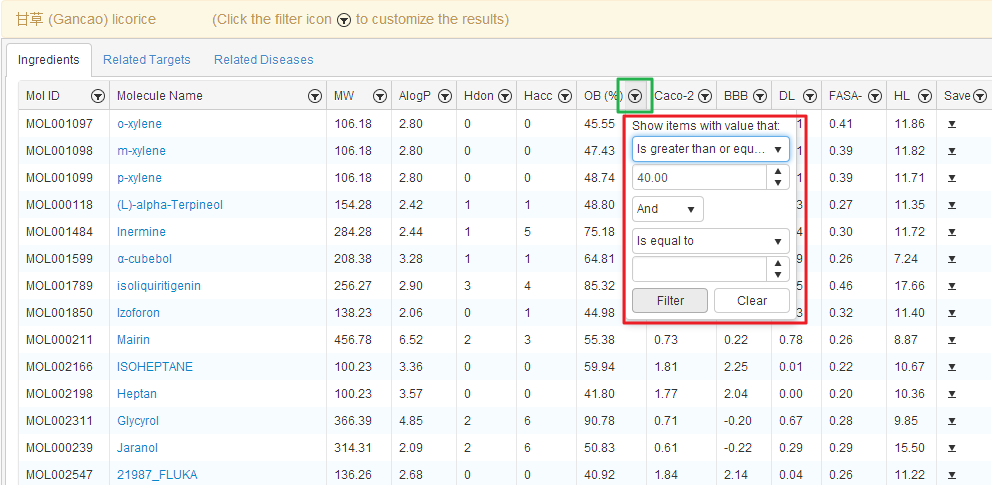
Figure 3.Graphical representation of screening active compounds, users can obtain the ideal active compounds by using the filter icon (green box) and filter rules (red box)
4) Target identification. Besides, the whole compounds-targets interactions that associated with the ingredients (under the criterion of OB ≥20% or DL ≥ 0.1) in licoricecan be obtained in the “Related Targets” page. We make the molecule name “equalto” mairin (Figure 4), then four associated target proteins with their target name, DrugBank ID and validated status information would appear.
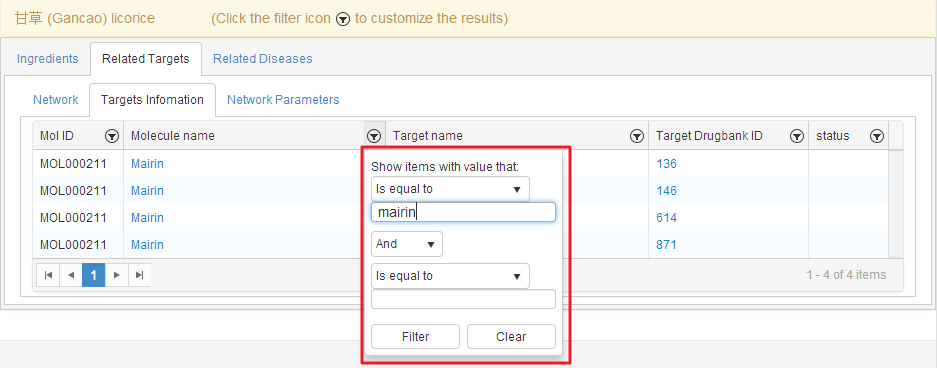
Figure 4.Graphical representation of identifying target, users can get a certain compound’s diseases marked in red box
The comprehensive topological “network” (Figure 5) that constructed under the standards of compounds’OB greater than 20%, or the DL greater than 0.1 in our database, can be downloaded in XGMML format. This XGMML format network file can be imported into Cytoscape software, and been analyzed with the powerful NetworkAnalyzer plugin (Assenov et al., 2007).The comprehensive compounds targets interaction integrated in TCMSP not only develop strategies uncovering the target site of medicinal herbs, but also offer opportunity for users to deeply researching and understanding the action mechanism on more TCMs.
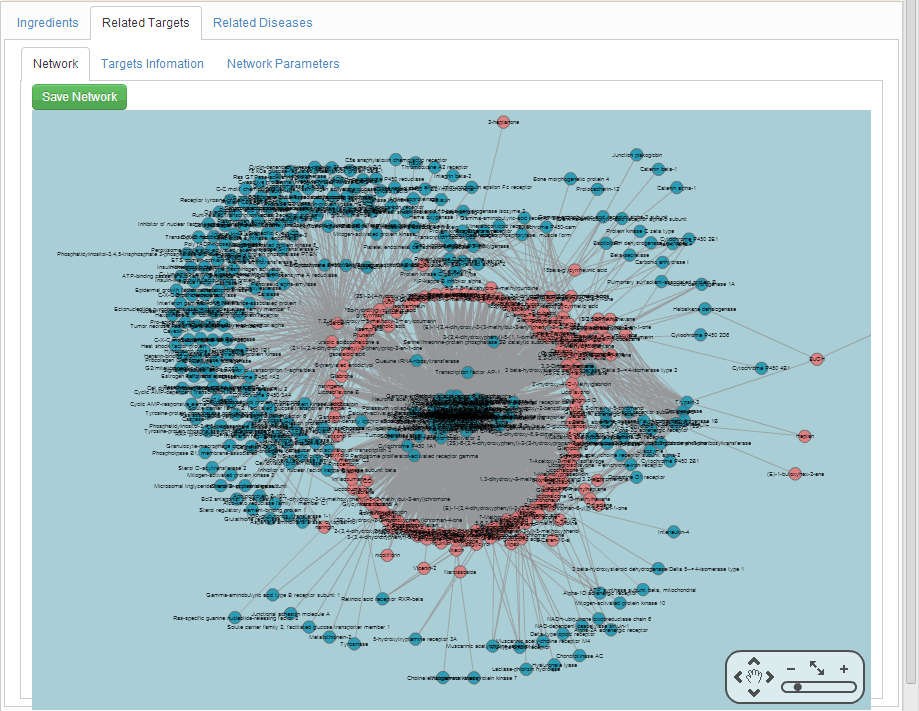
Figure 5.Network representation of ingredient-target interactions with ingredients (pink nodes) and targets (blue nodes)
5) Diseases analysis. Furthermore,an integrated target-disease interaction including disease information, target-disease network and network parameters of licorice also can be obtained in our platform. This platform also allows users to get a certain target’s diseases. For instance, as shown in Figure 6, we set the target name “equal to” estrogen receptor (targeted by mairin), and 8 diseases associated with estrogen receptor will be presented.
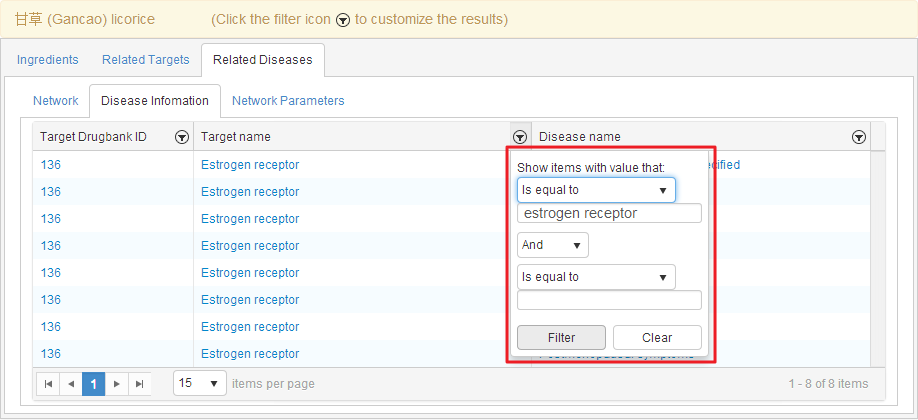
Figure 6. Graphical representation of diseases searching, users can get a certain target’s diseases in the filter icon marked in red box
Similarly, the target-disease network (as shown in Figure 7) can also be downloaded and further analyzed in Cytoscape with NetworkAnalyzer plugin. The overall target disease relationships and their corresponding editable network provided in TCMSP will help us thoroughly revealing the therapeutic efficiency of TCMs.
Figure 7.Network representation of target-disease interactions with targets (pink nodes) and diseases (blue nodes)
Otheruses of TCMSP
The TCMSP has also been applied in uncovering of drug combination theory (Yao et al., 2013), dissection nature of “qi” and “blood” in TCM (J. Liu et al., 2013), types of coronary artery disease in TCM (Zhou and Wang, 2014), revealing herbal medicine synergy (Wang et al., 2013), mechanisms of action for TCM formula (Li et al., 2012), development of new herbal combination (P. Li et al., 2014), and etc. Other groups have also applied to reveal syndrome prediction for coronary artery disease (Lu et al., 2012) and mechanisms of Eucommia ulmoides Oliv (Y. Li et al., 2014).
Moreover, we have made our database as flexible as possible to meet more users’ needs, as it offers a simple solution in a limited domain for a complex scientific research system. The large numbers of entries, powerful function of filters, ability of identifying drug-targets and creation of target-disease networks would beneficial for revealing the underlying mechanisms of action of Chinese herbs,as well as providing new strategies for drug discovery.
References
Assenov,Y.et al. (2007) Computing topological parameters of biological networks. Bioinformatics,24, 282–284.
Li,P. et al. (2014) Systems pharmacologystrategies for drug discovery and combination with applications tocardiovascular diseases. J. Ethnopharmacol., 151, 93–107.
Li,X. et al. (2012) A System-LevelInvestigation into the Mechanisms of Chinese Traditional Medicine: CompoundDanshen Formula for Cardiovascular Disease Treatment. PLoS ONE, 7,e43918.
Li,Y. et al. (2014) Investigation into themechanism of Eucommia ulmoides Oliv. based on a systems pharmacology approach. J.Ethnopharmacol., 151, 452–460.
Liu,H. et al. (2013) Systems approaches andpolypharmacology for drug discovery from herbal medicines: An example usinglicorice. J. Ethnopharmacol., 146, 773–793.
Liu,J. et al. (2013) A Systems-PharmacologyAnalysis of Herbal Medicines Used in Health Improvement Treatment: PredictingPotential New Drugs and Targets. Evid. Based Complement. Alternat. Med.,2013, 1–17.
Lu,P. et al. (2012) In Silico SyndromePrediction for Coronary Artery Disease in Traditional Chinese Medicine. Evid.Based Complement. Alternat. Med., 2012.
Wang,X. et al. (2013) Systems pharmacologyuncovers Janus functions of botanical drugs: activation of host defense systemand inhibition of influenza virus replication. Integr. Biol., 5,351.
Yao,Y. et al. (2013) Deciphering thecombination principles of Traditional Chinese Medicine from a systemspharmacology perspective based on Ma-huang Decoction. J. Ethnopharmacol.,150, 619–638.
Zhou,W. and Wang,Y. (2014) A network-based analysisof the types of coronary artery disease from traditional Chinese medicineperspective: Potential for therapeutics and drug discovery. J.Ethnopharmacol., 151, 66–77.